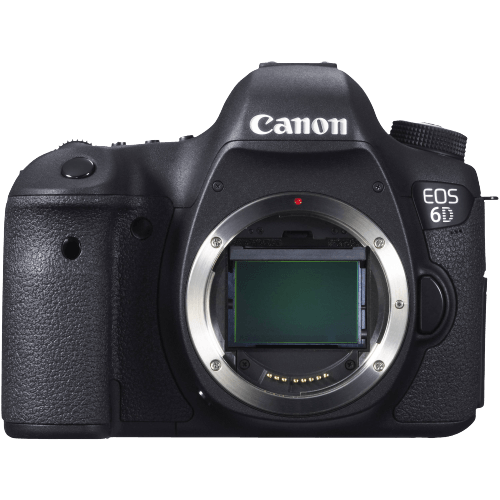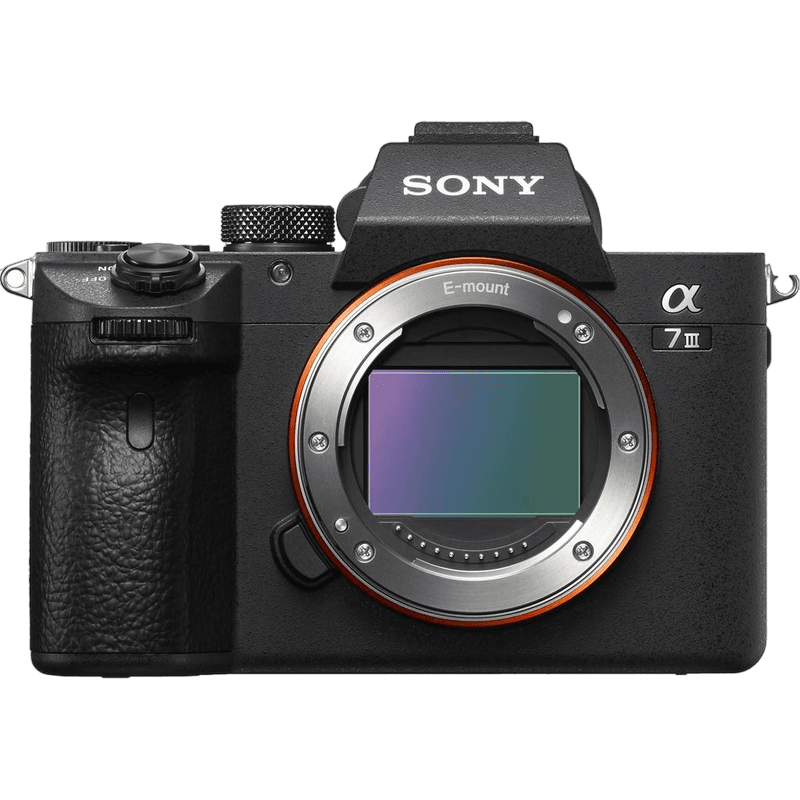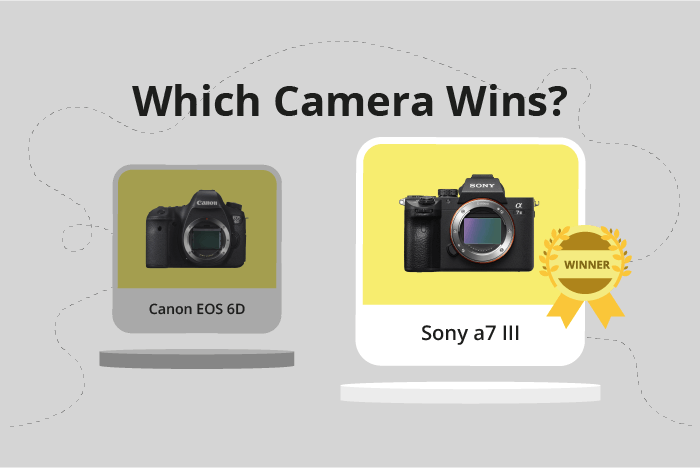Canon EOS 6D vs Sony a7 III Comparison
Canon EOS 6D

Sony a7 III

The Sony a7 III outshines the Canon EOS 6D with a score of 81 compared to 59/100. Both cameras share some specifications, such as their launch prices, with the Canon EOS 6D at $2099 and the Sony a7 III at $2000. Additionally, their sizes are relatively similar with only a slight difference in dimensions.
The Sony a7 III has the advantage of being a mirrorless camera, offering a more compact and lightweight design. It weighs only 650g (1.43lbs), compared to the Canon EOS 6D’s 770g (1.70lbs). This makes the Sony a7 III more portable and convenient for photographers on the go.
On the other hand, the Canon EOS 6D is a DSLR, which may appeal to some photographers who prefer the traditional design and optical viewfinder. However, its announcement and release in 2012 make it an older model, which could be a drawback compared to the more recent Sony a7 III released in 2018.
Taking all these factors into account, the Sony a7 III emerges as the superior choice due to its higher score, lighter weight, and more recent release. While the Canon EOS 6D may still appeal to some, the Sony a7 III offers greater advantages for most photographers.
Canon EOS 6D vs Sony a7 III Overview and Optics
The Sony a7 III triumphs over the Canon EOS 6D in optics, boasting a score of 81/100 as opposed to the 6D’s 61/100. Both cameras share some common specifications, such as a CMOS sensor, full-frame sensor size, and distinct lens mounts – Canon EF for the 6D and Sony FE for the a7 III.
The Sony a7 III outperforms the Canon EOS 6D in several aspects. Firstly, it has a higher megapixel count of 24.2, which results in more detailed images compared to the 6D’s 20.2 megapixels. The a7 III also has a faster shooting speed of 10 frames per second, double the 6D’s 4.5, allowing for better capture of fast-moving subjects. Furthermore, the a7 III’s image stabilization feature is a significant advantage, ensuring sharper images in challenging shooting conditions. Its superior DXOMARK sensor score of 96, compared to the 6D’s 82, solidifies the a7 III’s better overall image quality.
However, the Canon EOS 6D is not without its merits. Its Digic 5+ processor is well-regarded for producing excellent color reproduction and noise reduction. While it may not surpass the a7 III’s Bionz X processor, it still delivers quality results.
Taking all factors into account, the Sony a7 III emerges as the superior choice for optics, with its higher megapixel count, faster shooting speed, image stabilization, and better sensor score. While the Canon EOS 6D provides decent image quality and performance, it falls short of competing with the a7 III’s more advanced features and capabilities.
Canon EOS 6D vs Sony a7 III Video Performance
The Sony a7 III outperforms the Canon EOS 6D in video capabilities with a score of 70 to 43. Both cameras share some common specifications, such as a maximum video frame rate of 30fps. However, the Sony a7 III surpasses the Canon EOS 6D in other aspects, making it the superior choice for video recording.
The most significant advantage of the Sony a7 III is its 4K video resolution, with maximum dimensions of 3840 x 2160. In contrast, the Canon EOS 6D only offers Full HD video resolution, limited to 1920 x 1080 dimensions. The higher video resolution of the Sony a7 III allows for more detailed and sharper footage, which is particularly beneficial for professional videographers and content creators.
However, the Canon EOS 6D still has its merits despite the lower video score. For casual users or those primarily focused on photography, the Full HD video resolution may be sufficient for their needs. Additionally, both cameras have the same maximum video frame rate, ensuring that they can capture smooth motion in their videos.
Comparing the video capabilities of the Canon EOS 6D and the Sony a7 III, it is clear that the Sony a7 III is the better choice for those prioritizing video quality and resolution. The 4K resolution significantly enhances the detail and sharpness of the footage, making it more suitable for professional use. However, the Canon EOS 6D may still be adequate for those who do not require the highest video quality and are more focused on photography.
Canon EOS 6D vs Sony a7 III Features and Benefits
The Sony a7 III triumphs over the Canon EOS 6D in features, earning a score of 81/100 compared to the latter’s 57/100. Both cameras share some specifications, such as a 3-inch screen size and WiFi connectivity. However, the Sony a7 III outshines the Canon EOS 6D in several aspects.
The Sony a7 III boasts a touchscreen, which the Canon EOS 6D lacks. This feature allows for easier navigation and control, providing a more user-friendly experience. Additionally, the Sony a7 III has a flip screen, which enables photographers to capture images from various angles and positions, increasing versatility. The Sony a7 III also offers Bluetooth connectivity, enhancing its compatibility with other devices and allowing for seamless file transfers.
Despite the lower score, the Canon EOS 6D has its advantages. It features a higher screen resolution of 1,040,000 dots, compared to the Sony a7 III’s 921,600 dots. This results in a clearer and sharper display, aiding photographers in previewing their images with better detail. Furthermore, the Canon EOS 6D is equipped with GPS, enabling users to geotag their photos and track their shooting locations, a feature absent in the Sony a7 III.
Taking these points into consideration, it is evident that the Sony a7 III excels in terms of features, offering a touchscreen, flip screen, and Bluetooth connectivity. On the other hand, the Canon EOS 6D provides a higher screen resolution and GPS functionality. Ultimately, the choice between the two cameras depends on the individual photographer’s needs and preferences.
Canon EOS 6D vs Sony a7 III Storage and Battery
The Sony a7 III wins in the storage and battery category with a score of 81, while the Canon EOS 6D scores 45/100. Both cameras have common specifications, such as accepting SD, SDHC, and SDXC memory cards.
The Sony a7 III outperforms the Canon EOS 6D with two memory card slots, providing more storage options and flexibility. It also accepts Memory Stick Duo, Pro Duo, and Pro-HG Duo cards, offering additional compatibility. However, the Canon EOS 6D has a longer battery life, lasting 1090 shots compared to the Sony a7 III’s 750 shots. This advantage makes the Canon EOS 6D more suited for extended shooting sessions without needing to replace the battery.
Even though the Canon EOS 6D has better battery life, the Sony a7 III’s overall storage and battery capabilities prove superior due to its additional memory card slot and wider card compatibility.
Canon EOS 6D vs Sony a7 III – Our Verdict
Are you still undecided about which camera is right for you? Have a look at these popular comparisons that feature the Canon EOS 6D or the Sony a7 III:

